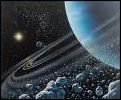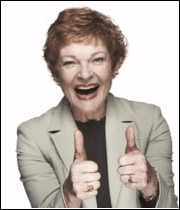Guest Astrologer
Donna Cunningham
NeptuneCafe presents
Part Three in a series
about Saturn and Uranus
Saturn and Uranus opposed each other in 2010, marking a tempestuous interval and a critical turning point.

advertisements
Saturn-Uranus Aspects
Understanding the square,
trine and opposition; plus
Saturn-Uranus in maturity
She has a Master’s degree in Social Work from Columbia University and over 40 years of experience in working with people. Her ebooks can be found at Moon Maven Publications Visit her blog at skywriter.wordpress.com.
About the Author: Donna Cunningham is an internationally-respected author of books, articles, and columns about astrology, flower essences and other metaphysical topics. Her insights reflect her dual background in astrology and psychotherapy.
The material on this page is excerpted with permission from Donna Cunningham's eBook, titled
Aspects between the Outer Planets: The Outer Planets and Inner Life, v.3
For more information on this and several other of her eBooks, visit www.moonmavenpublications.com
questions, comments? email wolfstar@neptunecafe.com


Worried about the Cardinal T-square of Pluto, Saturn, and Uranus?
See a huge collection of useful articles on how to handle those transits by over 50 talented astrologers.
The International Astrology Day Blogathon
will help you sort it out at:
and Saturn, but no square between Uranus and Neptune, and only a very wide conjunction between Saturn and Neptune in Libra. It was self-help icon, John Gray, who wrote the series of books that began with Men are from Mars; Woman are from Venus. Saturn and Uranus make a t-square with his Capricorn Moon. While never publicly acknowledging astrology, his AstroDataBank record notes that he is familiar with it and open-minded.
Most examples of the square from that period weave Neptune into the picture, and they’re a fascinating and complex lot. On the positive side, Neptune can add the qualities of spirituality, sensitivity, intuition, creative artistry, compassion and service to the mix; used less constructively, it can create denial, an addictive personality, a sense of martyrdom, or playing the victim. Let’s look at two people who’ve done an admirable job of blending all these energies.
A Curious Case of Date Twins with the Square: In an AstroDataBank search of the list of Uranus-Saturn squares combined with Neptune aspects were two familiar names, self-help author, Caroline Myss and astrologer, Karen Hamaker-Zondag, both born on December 2, 1952. Both were born with Uranus squaring a close conjunction of Neptune and Saturn in their charts, but with different birth times and locations and thus different house placements and Ascendants. Having seen both of them, I wouldn’t have guessed they were date twins, as their presentation of themselves is so different.
Considered in more depth in the Saturn-Neptune chapter, Caroline Myss is very much a tough love type–those who are looking for an enabler will need to look elsewhere. In her popular workshops and her very successful book, Why People Don't Heal and How They Can, she insists that people explore their chronic illnesses and understand why they can’t get free of them. With outspoken Sagittarius on the Ascendant, she asserts that people become attached to their illnesses because of the attention and sympathy they gain from others and because illness gives them an “out” of things they really do not want to do. Her body of work straddles alternative and mainstream branches of health care—her Master’s degree is in theology, and her Ph.D. is in Energy Medicine. (Another tough-minded metaphysical guru with the combination of Uranus in Cancer squaring Neptune and Saturn in Libra is Marianne Williamson, the well-known teacher of A Course in Miracles.)
Internationally recognized Dutch astrologer, Karen Hamaker-Zondag has taught all over the world and has written 16 widely-translated books. In 1980, she began her own School for Astrology, a four-year course of studies, along with a three-year course with her husband in Jungian Psychology. She has published a quarterly astrological journal since 1991 and in 1987 founded a school of Jungian psychology. She won the Regulus Award for Education in 1998. With Pisces rising, she is as mystical as Caroline Myss, but her presentation is that of a gentle, caring soul who is nonetheless realistic. (Two other astrologers born in this era with the combination of Uranus-Saturn-Neptune aspects strongly featured are Caroline Casey and Antero Alli.)
The Trine: I must confess to having little grasp of the traits of people with the trine between Saturn and Uranus, nor was the AstroDataBank search especially enlightening. It may be that they mostly fly under the radar in their expressions of Uranus. This planet describes our relationship to our culture in terms of what is considered unconventional and rebellious on one hand and exciting and innovative on the other. Many people with trines to Uranus get away with being different because they are comfortably and even amiably eccentric, not feeling the need to get in people’s faces with their eccentricity. Entertainers in AstroDataBank with Uranus-Saturn trines who match this pattern include Kelsey Grammer and Bruce Willis, plus Mel Gibson and Howie Mandel with out-of-sign trines.
A trine is an aspect of harmonious and easy expression; although people with trines to Uranus are generally different and on the leading edge, their “differences” are often in harmony with the spirit of their time and their generation. When the trine is between Uranus and Saturn, they may be seen as bright, capable and interesting, but without any particular axe to grind or radical agenda to push, and so they meet little resistance to their goals. Besides Mark Pottenger, astrologers in AstroDataBank with Uranus trine Saturn include Joseph Goodavage, Doris Chase Doane, Jodie Forrest, and Kim Rogers-Gallagher.
The Opposition: In most planetary pairs I’ve studied in depth, there are fewer notables with oppositions in AstroDataBank than any other aspect, and this is again the case with Uranus and Saturn. I found very few astrologers with that combination, the most noted being John Addey, born in 1920 and best known for his work with harmonic charts.
It has long been remarked that the generation born in the 1960s has produced few astrologers, and there were very few in AstroDataBank. With both Uranus and Pluto in Virgo and Saturn in Pisces, they seem, at least among my clients over the years, to be concentrated in the fields of technology and health care—both mainstream and alternative.
Living with Uranus-Saturn aspects over the long haul can iron out the contradictions between them, as the means of expression and the relative strengths of these two planets change over the course of a lifetime. Children and preteens have little latitude to control their own lives, and so children can café at the authority of parents and teachers.
Adolescence and young adulthood are the heydays of Uranus, as we gain increasing freedom. In our 20s and 30s, the necessity of earning a living means dealing with bosses and impinges on our freedom, yet over time can present the opportunity to hone our skills and to experience the gratification of solid accomplishments.
In our 40s, when transiting Uranus opposes natal Uranus and Saturn opposes natal Saturn, we come to a midlife crisis in which we reevaluate whether the forms we have built in our lives really allow us to express our individuality and our special gifts and interests. Depending on house locations of the natal and transiting placements this juncture can be accompanied by dramatic shifts in career, location, or partnerships. Past the second Saturn return in the late 50s, Saturn—like gravity—tends to take over.


The Square: In general, people with prominent Uranus squares can experience considerable shame about being different and may be driven to try to resolve these feelings by blaming society and being judgmental, even arrogant, toward others with less commitment to change. Some of them respond to social pressure by flaunting their differences in a hard-edged manner. Rather than serving as a bridge between two segments of society, as the conjunction and trine can do, they often seek to force a confrontation. In the case of a Uranus square to Saturn, however, innate caution or early exposure to consequences of rebellion can make them tone down their expression of dissent as the years go on.

As noted earlier, during most of the time the Uranus-Saturn square of 1951-52 was in effect, Saturn was also conjunct Neptune, making it hard to get a sense of the square by itself. I did find one example with a tight square between Uranus
The opposition represents the most extreme polarization of the energies of any planetary pair, as the person typically handles the tension by disowning one of the planets and projecting its undesirable qualities onto others. People with oppositions to Uranus often justify antisocial behavior by saying in effect, “Look what they made me do!” This seems all the more true with Uranus-Saturn oppositions because they are polar opposites to begin with. We may observe one of two patterns—either they take the Uranian position and blame the authorities for their conduct, or else they take on Saturn’s role and rigidly try to contain and control the behavior of people who act in Uranian ways.
A dramatic example of political polarization occurred during 1965-67. It was a memorable era of strong social activism and even stronger attempts by the authorities to suppress it. However, the additions of Pluto, Chiron, and Neptune to the astrological picture make that a less than perfect case, so it’s difficult to delineate the part the opposition plays in the psychology of people born during that complex period.
One common scenario, however, does seem to pertain largely to the combined influence of Saturn in Pisces and Uranus in Virgo. Many of them feel they’re compelled to sacrifice their ideals, true vocation, and innate gifts because of the limits and constraints of today’s workplace and authority structure in an inhumane society. In the first decade of the New Millennium, this group collectively experienced a midlife upheaval, and many have concluded they could no longer operate within a traditional workplace.
The next instance of the opposition is years 2008-10, this time with Uranus in Pisces and Saturn in Virgo. Since that’s the same combination as the opposition of 1920, the Pisces-Virgo axis appears to be part of a longer Uranus-Saturn cycle. With no other outer planets in the mix of aspects, we’ll be able to see a purer picture of the two planets acting alone, but we’re years away from knowing how it will shape the personalities and lives of children born with it.
There is, however, a certain tolerance and even a fondness in our society for feisty, eccentric older people, so with the freedom retirement brings, our Uranian qualities may re-emerge full strength. People with strong Saturn aspects tend to get better as they get older, and so the gifts, skills, and unique perspectives of people with Uranus-Saturn
aspects typically evolve into an impressive collection over the course of a lifetime. As an inspiring example, in his 65th year Rob Hand was granted a rare lifetime achievement award at the 2008 United Astrology Congress to a standing ovation of 1700 of his peers. Transiting Uranus was conjunct his Midheaven at the time, and as the Uranus-Saturn opposition formed across his Midheaven-IC axis, he was in the process of completing his dissertation for a PhD in medieval history.
Uranus-Saturn Aspects and Maturity -- Getting Older AND Bolder

